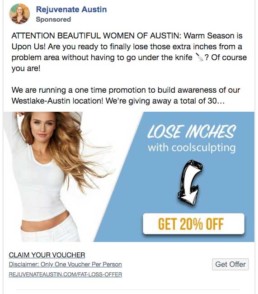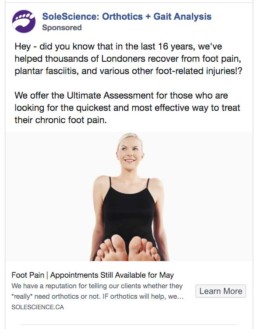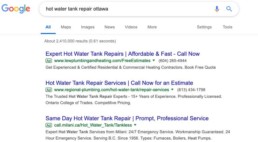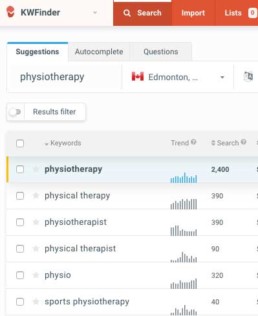Facebook vs. Google Ads – which one is right for your business?
Facebook vs. Google Ads – which one is right for your business?
Online Marketing Level: Beginner Read
Facebook Ads have long been a popular choice for independent and small to medium-sized businesses as they provide a reasonably affordable opportunity for advertising products and services online. But as more and more companies are now advertising with Facebook Ads, the competition has increased and so has the cost per click.
Maybe you are also struggling with the continuously increasing costs of your ads on Facebook? And thinking about giving Google Ads a try? Or are you wondering if you should combine Google Ads with Facebook Ads?
In this article we’ll explore:
• the differences between ad formats on Google and Facebook.
• which network is right for your business.
• what you should keep in mind for Google Ads campaigns to be effective and cost effective.
Advertising formats on Google
Both advertising networks, Facebook and Google, offer a multitude of ad formats. In Google Ads you can serve text ads. But there is much more that you can do with it. For example, online stores have the option of displaying their products in Google Search, including image and price. In addition, you can advertise with banners and video ads on other websites.
In this post, we’ll focus on comparing Facebook Ads and Text Ads on Google Search. These are 2 of the most common and effective advertising channels.
Google Text Ads vs. Facebook Ads
Which are better for your business – Facebook or Google Ads? Well, there is no black and white answer to this question. First, let’s take a look at the purpose of each platform. How do we use Facebook or Google?
Google is a search engine. People use Google to find information, answers or even specific products or services. They have a defined search intent, meaning they have a specific need and are actively looking for a solution.
Ads in Google Search contain text and links but no images. Here is an example of a Google Text Ad:

Facebook is a network. Facebook is all about meeting and exchanging information. We log into Facebook to see what our friends are up to, look at holiday pictures, or share an opinion. People using Facebook typically are in what we call “leisure mode,” they seek distraction and entertainment.
Facebook Ads contain text, links, pictures and videos. Here is an example of a Facebook Ad:

Create Awareness on Facebook
Facebook is ideal to reach those who have a need, but who are not actively searching for anything. It’s a great way to draw attention to unknown solutions, new offers or visually attractive products.
The combination of image and text (or video and text) allows you to address users on different perceptual channels.
Your ad needs to draw attention and generate interest. When scrolling through the newsfeed, the content of your ad needs to address a reader’s need that they may not have been aware of until now. And it needs to stand out visually and interrupt the user.
Example:
Mike is a teacher who works on his feet all day long. He’s bothered by his feet but it’s not to the point where he’s going to Google to look for a treatment option. On Facebook he stumbles across an add promoting a free foot assessment from a physiotherapist in his area. He never considered his feet might be the source of his sore back, but the ad speaks to his issue, so he clicks on the ad.

What’s special about Facebook Ads: You target your ad to personal interests and traits, such as age and gender, of those who should see your ad. That’s why it’s so important to know your target audience as well as possible when you run Facebook Ads. You need to learn all about them: what they like, what their needs are, what’s challenging for them and so on.
Offer Solutions with Google Ads
Ads in Google Search will only reach those who are actively looking for a particular solution or product. Your ads will appear in Google search when someone looks for exactly what you are offering.
Google Ads campaigns are therefore based on the search intent and the behavior of users on Google. This means that in order to promote your product or service with Google your offer must be known.
Example:
Katja has an issue with her hot water tank in her some. She searches on Google for “hot water tank repair”. She will then be shown ads by various plumbing providers serving Google Ads.

Special feature of Google Ads: Google Ads are always based on keywords. So the key here is to create a list of relevant keywords surrounding the products and services that you are offering.
For Google Ads you don’t need to define a target audience. They are based on a list of thematically grouped keywords and ads with matching texts.
While the ads are based on keyword lists and search behavior, it is still an advantage if you know your target audience well. Your ad is not the only one that appears. It’s very likely that your competitors advertise with the same keywords on Google. Remember, the ads appear on top of each other grouped together or at the bottom of the page.
The better you know the needs of your audience, the easier it is to create ad copy that resonates with your target audience.
4 Helpful Factors for Your Decision
So how do you decide which type of ad works best for your business?
Whether you choose Google or Facebook ads depends primarily on how well known your product or service is and how your audience is behaving. Additional important factors are costs and objectives.
Let’s take a closer look at all four points:
1. Is there any Search for your Product or Service in Google?
That’s the key question! If you can clearly answer it with “No,” then Google Ads make less sense. If you are unsure, then you can easily find the search volume with a free tool like kwfinder. Suppose you want to know if and how often “Physiotherapy” is googled in Edmonton Canada. You enter your keyword, loation and language:

Take into account that your favourite client may use different words or colloquial language instead of the usual technical terminology. You can ignore uppercase and lowercase letters, as they aren’t relevant to Google.
After clicking on “Find keywords” you will get the result on a new page:

Tip: Log in to the kwfinder once with your email address. This will allow you to run 5 queries daily. You can sign up for the paid option if you need to run more queries within 24 hours.
If there is no search volume then the tool displays the value “N / A” instead of a number. No search volume = no Google Ads.
What search volume do you need for a keyword list to make Google Ads worthwhile?
There is no rule for it. However, you can calculate it based on an expected click and conversion rate.
A good click-through rate (clicks to impressions ratio) on Google Ads across all industries is 5%. The average conversion rate is roughly 2%. Note, these vary widely by industry.
If you don’t achieve these rates, keep in mind that these are cold contacts. In addition, you always have to remember you’re competing for real estate on Google. Most people compare multiple quotes before they buy. It’s therefore hard to compare the click and conversion rates of Facebook and Google. The requirements are simply too different.
Again, the click and conversion rates for Google Ads can vary widely. Factors that influence these include competition, how well your campaigns are structured, your ad copy and the design of your landing pages.
The above values are approximations that should give you a rough ballpark of where you should aim. In industries with little competition, higher click through rates are possible.
Here are some basic examples of scenarios that affect click and conversion rates for Google Ads:
- The more appealing your ad text is, the higher your click-through rate will be.
- The more appropriate your keywords are for the ad text, the higher the click-through rate.
- The more competitors run ads, the lower the click-through rate.
- The more convincing your landing page, the higher the conversion rate.
- The more expensive your offer, the lower the conversion rate.
A reasonable and attainable goal for Google Ads is a click-through rate of 10%. Whether that pays off depends on what you offer, your conversion goal, and the cost per click. We’ll take a look at the cost factor in a bit, but let’s first look at another important aspect.
2. Is Your Desired Customer Actively Searching?
Suppose you know for certain that your product or service is being searched for on Google.
But are the searchers really your target group? You can only answer that question if you have already dealt in detail with your desired customer. Just because there is search volume on Google does not mean that it is automatically your target audience that is searching.
Example:
I have e.g. two very different target groups. Some are male and under 35. The other group is female and over 40. Both find me in different ways: the first group finds me almost exclusively through Google Search and the latter comes via Facebook. Both are very different in behavior, but they have the same need.
So looking at the search volume alone doesn’t provide enough information to make your decision. It’s also about the behavior of your target audience. Which leads us directly to the next point.
3. What Do You Want to Achieve?
- Advertise a freebie to build your newsletter mailing list.
- Generate traffic to attract more readers to your blog and increase awareness.
- Generate traffic to test different sales landing pages.
- Receive a registration for a paid course or webinar.
- Sale of offers or products.
At the very beginning we looked at the fact that the intention of the users on Facebook is different than on Google. This helps you to choose the right platform for your goals:
If you’re in the business of selling a specific product or service that has a high search volume, you’re likely to get a better conversion rate on Google. Because users that are looking on Google for a product or service already have a high purchase intent.
Users on Facebook often find ads annoying. They want to be entertained and distracted. There, you can best reach your goals with ads promoting information, such as: interesting blog articles or freebies.
In some cases, it may be useful to promote a blog post with Google Ads. For example, to announce a new blog that does not yet rank organically in Google. Or because there is a lot of search volume on certain topics that you blog about. But in most cases, Google Ads are simply too costly to use for generating traffic or building an email-list long term.
Which brings us to the last point, the cost of ads.
4. Which Platform has the Better Price-Performance Ratio?
A comparison of the platforms in terms of prices is difficult. It starts when looking at the cost for clicks:
- For Facebook, you have the option to pay for both ad impressions (CPM = cost per 1000 impressions) and clicks (CPC = cost per click). For Google text ads, you pay only for clicks.
- A click on Google is equivalent to a website visitor (or caller). On Facebook, a click can also be like-click or a click on a picture.
It’s best to compare at the conversion level. Try out both platforms and compare the cost per conversion.
Here’s a hint about Google Ads click cost: The estimated click prices can also be viewed in the kwfinder tool. This gives you a first impression. The actual cost-per-click may be quite different.
The actual cost-per-click depends on the competition, as well as the quality features of your Google ads:
- Quality Score: Google awards a quality score for each keyword in the account. The better each keyword matches the content of the landing page that the ads target, the higher the Quality Score. The higher the Quality Score, the lower the cost-per-click can be.
- Performance of the campaigns: campaigns that consistently achieve high quality with very good click through rates and conversion rates can count on low cost-per-clicks in the long term.
- Competition: If keywords are highly competitive, this can drive up the cost of clicks.
Conclusions
As you can see, there isn’t an easy answer. Whether you should run ads on Google or Facebook depends on a number of factors.
First, check the search volume on Google and think about what the goal of your campaign should be. That should help you decide. Incidentally, the two channels can work wonderfully together when combined. So you can, for example, place a campaign on Facebook. And when people go to the search engine to find you, they’ll find you through your Google ads.
Do you want to learn more about Google Ads? What you need to keep in mind to bring you exactly those website visitors that are looking for your offer?

